Simulating the Effects of Land Surface Characteristics on Planetary Boundary Layer Parameters for a Modeled Landfalling Tropical Cyclone
Abstract
:1. Introduction
2. Materials and Methods
2.1. Nature Run and Case Selection
2.2. Model Description and Experiment Design
2.3. Model Output Verification and Variables Comparison
2.4. Statistical Methods
3. Results
3.1. Model Output Validation
3.1.1. Storm Tracks
3.1.2. Storm Intensity
3.1.3. Storm Size
3.1.4. Environmental Moisture
3.2. PBL Variables
3.2.1. PBL Properties before Interaction with the Storm
3.2.2. PBL Properties during Interaction with the Storm
3.3. Precipitation Accumulation and Area
4. Discussion and Conclusions
Author Contributions
Funding
Institutional Review Board Statement
Informed Consent Statement
Data Availability Statement
Acknowledgments
Conflicts of Interest
References
- Malkus, J.S.; Rhiel, H. On the dynamics and energy transformations in steady-state hurricanes. Tellus 1960, 12, 1–20. [Google Scholar] [CrossRef] [Green Version]
- Gamache, J.F.; Houze, R.A.; Marks, F.D. Dual-aircraft investigation of the inner-core of Hurricane Norbert.3. Water-budget. J. Atmos. Sci. 1993, 50, 3221–3243. [Google Scholar] [CrossRef] [Green Version]
- Trenberth, K.E.; Davis, C.A.; Fasullo, J. Water and energy budgets of hurricanes: Case studies of Ivan and Katrina. J. Geophys. Res. Atmos. 2007, 112, 11. [Google Scholar] [CrossRef]
- Andersen, T.K.; Radcliffe, D.E.; Shepherd, J.M. Quantifying surface energy fluxes in the vicinity of inland-tracking tropical cyclones. J. Appl. Meteorol. Climatol. 2013, 52, 2797–2808. [Google Scholar] [CrossRef]
- Shepherd, J.; Thomas, A.; Santanello, J.; Lawston-Parker, P.; Basara, J. Evidence of warm core structure maintenance over land: A case study analysis of cyclone Kelvin. Environ. Res. Commun. 2021, 3, 045004. [Google Scholar] [CrossRef]
- Arndt, D.S.; Basara, J.B.; McPherson, R.A.; Illston, B.G.; McManus, G.D.; Demko, D.B. Observations of the overland reintensification of Tropical Storm Erin (2007). Bull. Amer. Meteor. Soc. 2009, 90, 1079–1093. [Google Scholar] [CrossRef]
- Tuleya, R.E. Tropical storm development and decay: Sensitivity to surface boundary-conditions. Mon. Weather Rev. 1994, 122, 291–304. [Google Scholar] [CrossRef] [Green Version]
- Tuleya, R.E.; Bender, M.A.; Kurihara, Y. A simulation study of the landfall of tropical cyclones using a movable nested-mesh model. Mon. Weather Rev. 1984, 112, 124–136. [Google Scholar] [CrossRef] [Green Version]
- Tuleya, R.E.; Kurihara, Y. A numerical simulation of the landfall of tropical cyclones. J. Atmos. Sci. 1978, 35, 242–257. [Google Scholar]
- Andersen, T.K.; Shepherd, J.M. A spatio-temporal analysis of tropical cyclone maintenance or intensification inland. Int. J. Climatol. 2013, 10, 1002–1013. [Google Scholar] [CrossRef]
- Emanuel, K.; Callaghan, J.; Otto, P. A hypothesis for the redevelopment of warm-core cyclones over Northern Australia. Mon. Weather Rev. 2008, 136, 3863–3872. [Google Scholar] [CrossRef]
- Evans, C.; Schumacher, R.S.; Galarneau, T.J. Sensitivity in the overland reintensification of Tropical Cyclone Erin (2007) to near-surface soil moisture characteristics. Mon. Weather Rev. 2011, 139, 3848–3870. [Google Scholar] [CrossRef] [Green Version]
- Nair, U.S.; Rappin, E.; Foshee, E.; Smith, W.; Pielke, R.A.; Mahmood, R.; Case, J.L.; Blankenship, C.B.; Shepherd, M.; Santanello, J.A.; et al. Influence of land cover and soil moisture based brown ocean effect on an extreme rainfall event from a Louisiana Gulf Coast tropical system. Sci. Rep. 2019, 9, 17136. [Google Scholar] [CrossRef]
- Shen, W.X.; Ginis, I.; Tuleya, R.E. A numerical investigation of land surface water on landfalling hurricanes. J. Atmos. Sci. 2002, 59, 789–802. [Google Scholar] [CrossRef] [Green Version]
- Kimball, S.K. Structure and evolution of rainfall in numerically simulated landfalling hurricanes. Mon. Weather Rev. 2008, 136, 3822–3847. [Google Scholar] [CrossRef]
- Pielke, R. Comparison of 3 dimensional versus 2 dimensional numerical predictions of sea breezes over South Florida. Bull. Amer. Meteorol. Soc. 1973, 54, 752. [Google Scholar]
- Quintanar, A.I.; Mahmood, R.; Suarez, A.; Leeper, R. Atmospheric sensitivity to roughness length in a regional atmospheric model over the Ohio-Tennessee River Valley. Meteorol Atmos Phys 2016, 128, 315–330. [Google Scholar] [CrossRef]
- Avissar, R.; Pielke, R.A. A parameterization of heterogeneous land surfaces for atmospheric numerical-models and its impact on regional meteorology. Mon. Weather Rev. 1989, 117, 2113–2136. [Google Scholar] [CrossRef] [Green Version]
- Eltahir, E.A.B.; Pal, J.S. Relationship between surface conditions and subsequent rainfall in convective storms. J. Geophys. Res.-Atmos. 1996, 101, 26237–26245. [Google Scholar] [CrossRef]
- Pielke, R.A. Influence of the spatial distribution of vegetation and soils on the prediction of cumulus convective rainfall. Rev. Geophys. 2001, 39, 151–177. [Google Scholar] [CrossRef]
- Brunsell, N.A. Characterization of land-surface precipitation feedback regimes with remote sensing. Remote Sens. Environ. 2006, 100, 200–211. [Google Scholar] [CrossRef]
- Matsui, T.; Lakshmi, V.; Small, E.E. The effects of satellite-derived vegetation cover variability on simulated land-atmosphere interactions in the NAMS. J. Clim. 2005, 18, 21–40. [Google Scholar] [CrossRef]
- De Ridder, K. The impact of vegetation cover on sahelian drought persistence. Bound. Layer Meteor. 1998, 88, 307–321. [Google Scholar] [CrossRef]
- Matyas, C.J.; Carleton, A.M. Surface radar-derived convective rainfall associations with Midwest US land surface conditions in summer seasons 1999 and 2000. Theor. Appl. Climatol. 2010, 99, 315–330. [Google Scholar] [CrossRef]
- Trier, S.B.; Davis, C.A. Mesoscale convective vortices observed during BAMEX. Part II: Influences on secondary deep convection. Mon. Weather Rev. 2007, 135, 2051–2075. [Google Scholar] [CrossRef] [Green Version]
- Dyer, J.L.; Rigby, J.R. Assessing the sensitivity of lower atmospheric characteristics to agricultural land use classification over the Lower Mississippi River Alluvial Valley. Theor. Appl. Climatol. 2020, 142, 305–320. [Google Scholar] [CrossRef]
- Dorman, J.L.; Sellers, P.J. A global climatology of albedo, roughness length and stomatal-resistence for atmospheric general-circulation models as represented by the simple biosphere model (SIB). J. Appl. Meteorol. 1989, 28, 833–855. [Google Scholar] [CrossRef] [Green Version]
- Zha, J.L.; Zhao, D.M.; Wu, J.; Zhang, P.W. Numerical simulation of the effects of land use and cover change on the near-surface wind speed over Eastern China. Clim. Dyn. 2019, 53, 1783–1803. [Google Scholar] [CrossRef]
- Lyons, T.J.; Smith, R.C.G.; Xinmei, H. The impact of clearing for agriculture on the surface energy budget. Int. J. Climatol. 1996, 16, 551–558. [Google Scholar] [CrossRef] [Green Version]
- Segal, M.; Garratt, J.R.; Kallos, G.; Pielke, R.A. The impact of wet soil and canopy temperatures on the daytime boundary-layer growth. J. Atmos. Sci. 1989, 46, 3673–3684. [Google Scholar] [CrossRef]
- Chen, F.; Avissar, R. Impact of land-surface moisture variability on local shallow convective cumulus and precipitation in large-scale models. J. Appl. Meteorol. 1994, 33, 1382–1401. [Google Scholar] [CrossRef] [Green Version]
- Li, X.; Mitra, C.; Dong, L.; Yang, Q.C. Understanding land use change impacts on microclimate using Weather Research and Forecasting (WRF) model. Phys. Chem. Earth 2018, 103, 115–126. [Google Scholar] [CrossRef]
- Yang, L.; Smith, J.A.; Baeck, M.L.; Bou-Zeid, E.; Jessup, S.M.; Tian, F.Q.; Hu, H.P. Impact of urbanization on heavy convective precipitation under strong large-scale forcing: A case study over the Milwaukee-Lake Michigan region. J. Hydrometeorol. 2014, 15, 261–278. [Google Scholar] [CrossRef]
- Rogers, R.F.; Davis, R.E. The effect of coastline curvature on the weakening of Atlantic tropical cyclones. Int. J. Climatol. 1993, 13, 287–299. [Google Scholar] [CrossRef]
- Konrad, C.E.; Meaux, M.F.; Meaux, D.A. Relationships between tropical cyclone attributes and precipitation totals: Considerations of scale. Int. J. Climatol. 2002, 22, 237–247. [Google Scholar] [CrossRef]
- Matyas, C.J. Processes influencing rain-field growth and decay after tropical cyclone landfall in the United States. J. Appl. Meteorol. Climatol. 2013, 52, 1085–1096. [Google Scholar] [CrossRef]
- Ding, L.D.; Li, T.; Xiang, B.Q.; Peng, M.L.D. On the westward turning of Hurricane Sandy (2012): Effect of atmospheric intraseasonal oscillations. J. Clim. 2019, 32, 6859–6873. [Google Scholar] [CrossRef]
- Evans, J.L.; Allan, R.J. El-Nino Southern Oscillation modification to the structure of the monsoon and tropical cyclone activity in the Australasian region. Int J. Climatol. 1992, 12, 611–623. [Google Scholar] [CrossRef]
- Kikuchi, K.; Wang, B. Formation of tropical cyclones in the northern Indian Ocean associated with two types of tropical intraseasonal oscillation modes. J. Meteorol. Soc. Jpn. 2010, 88, 475–496. [Google Scholar] [CrossRef] [Green Version]
- Chen, X.Y.; Wu, L.G. Topographic influence on the motion of tropical cyclones landfalling on the coast of China. Weather. Forecast. 2016, 31, 1615–1623. [Google Scholar] [CrossRef]
- Bender, M.A.; Ginis, I. Real-case simulations of hurricane-ocean interaction using a high-resolution coupled model: Effects on hurricane intensity. Mon. Weather Rev. 2000, 128, 917–946. [Google Scholar] [CrossRef]
- Ma, Z.H.; Fei, J.F.; Huang, X.G.; Cheng, X.P. Modulating effects of mesoscale oceanic eddies on sea surface temperature response to tropical cyclones over the western North Pacific. J. Geophys. Res. Atmos. 2018, 123, 367–379. [Google Scholar] [CrossRef]
- Reale, O.; Terry, J.; Masutani, M.; Andersson, E.; Riishojgaard, L.P.; Jusem, J.C. Preliminary evaluation of the European Centre for Medium-Range Weather Forecasts’ (ECMWF) Nature Run over the tropical Atlantic and African monsoon region. Geophys. Res. Lett. 2007, 34. [Google Scholar] [CrossRef] [Green Version]
- Andersson, E.; Masutani, M. Collaboration on observing system simulation experiments (Joint OSSE). ECMWF Newsl. 2010, 123, 14–16. [Google Scholar]
- Nolan, D.S.; Atlas, R.; Bhatia, K.T.; Bucci, L.R. Development and validation of a hurricane nature run using the joint OSSE nature run and the WRF model. J. Adv. Modeling Earth Syst. 2013, 5, 382–405. [Google Scholar] [CrossRef]
- Nolan, D.S.; Mattocks, C.T. Development and evaluation of the second hurricane nature run Using the Joint OSSE Nature Run and the WRF model. In Proceedings of the 31st Conference on Hurricanes and Tropical Meteorology, San Diego, CA, USA, 31 March–4 April 2014. [Google Scholar]
- Jiang, H.; Liu, C.; Zipser, E.J. A TRMM-based tropical cyclone cloud and precipitation feature database. J. Appl. Meteorol. Climatol. 2011, 50, 1255–1274. [Google Scholar] [CrossRef]
- Matyas, C.J. A geospatial analysis of convective rainfall regions within tropical cyclones after landfall. Int. J. Appl. Geospat. Res. 2010, 1, 69–89. [Google Scholar] [CrossRef] [Green Version]
- Rodgers, E.B.; Chang, S.W.; Pierce, H.F. A satellite observational and numerical study of precipitation characteristics in western North Atlantic tropical cyclones. J. Appl. Meteor. 1994, 33, 129–139. [Google Scholar] [CrossRef] [Green Version]
- Braun, S.A. High-resolution simulation of Hurricane Bonnie (1998). Part II: Water budget. J. Atmos. Sci. 2006, 63, 43–64. [Google Scholar] [CrossRef]
- Cerveny, R.S.; Newman, L.E. Climatological relationships between tropical cyclones and rainfall. Mon. Weather Rev. 2000, 128, 3329–3336. [Google Scholar] [CrossRef]
- Kimball, S.K.; Mulekar, M.S. A 15-year climatology of North Atlantic tropical cyclones. Part I: Size parameters. J. Climate 2004, 17, 3555–3575. [Google Scholar] [CrossRef]
- Hong, S.-Y.; Lim, K.-S.S.; Lee, Y.-H.; Ha, J.-C.; Kim, H.-W.; Ham, S.-J.; Dudhia, J. Evaluation of the WRF double-moment 6-class microphysics scheme for precipitating convection. Adv. Meteorol. 2010, 2010, 1–10. [Google Scholar] [CrossRef] [Green Version]
- Iacono, M.J.; Delamere, J.S.; Mlawer, E.J.; Shephard, M.W.; Clough, S.A.; Collins, W.D. Radiative forcing by long-lived greenhouse gases: Calculations with the AER radiative transfer models. J. Geophys. Res. Atmos. 2008, 113, D13. [Google Scholar] [CrossRef]
- Kain, J.S. The Kain-Fritsch convective parameterization: An update. J. Appl. Meteor. 2004, 43, 170–181. [Google Scholar] [CrossRef] [Green Version]
- Kain, J.S.; Fritsch, J.M. A one-dimensional entraining/detraining plume model and its application in convective parameterization. J. Atmos. Sci. 1990, 47, 2784–2802. [Google Scholar] [CrossRef] [Green Version]
- Hong, S.-Y.; Noh, Y.; Dudhia, J. A new vertical diffusion package with an explicit treatment of entrainment processes. Mon. Weather Rev. 2006, 134, 2318–2341. [Google Scholar] [CrossRef] [Green Version]
- Noh, Y.; Cheon, W.G.; Hong, S.Y.; Raasch, S. Improvement of the K-profile model for the planetary boundary layer based on large eddy simulation data. Bound. Layer Meteor. 2003, 107, 401–427. [Google Scholar] [CrossRef] [Green Version]
- Chen, F.; Dudhia, J. Coupling an advanced land surface-hydrology model with the Penn State-NCAR MM5 modeling system. Part I: Model implementation and sensitivity. Mon. Weather Rev. 2001, 129, 569–585. [Google Scholar] [CrossRef] [Green Version]
- Jorgensen, D.P. Mesoscale and convective-scale characteristics of mature hurricanes. Part I: General observations by research aircraft. J. Atmos. Sci. 1984, 41, 1268–1285. [Google Scholar] [CrossRef] [Green Version]
- Willoughby, H.E.; Marks, F.D.; Feinberg, R.J. Stationary and moving convective bands in hurricanes. J. Atmos. Sci. 1984, 41, 3189–3211. [Google Scholar] [CrossRef] [Green Version]
- Matyas, C.J. A spatial analysis of radar reflectivity regions within Hurricane Charley (2004). J. Appl. Meteorol. Climatol. 2009, 48, 130–142. [Google Scholar] [CrossRef]
- Ulbrich, C.W.; Miller, N.E. Experimental test of the effects of Z-R law variations on comparison of WSR-88D rainfall amounts with surface rain gauge and disdrometer data. Weather. Forecast. 2001, 16, 369–374. [Google Scholar] [CrossRef]
- Ulbrich, C.W.; Atlas, D. On the separation of tropical convective and stratiform rains. J. Appl. Meteor. 2002, 41, 188–195. [Google Scholar] [CrossRef]
- Tokay, A.; Short, D.A.; Williams, C.R.; Ecklund, W.L.; Gage, K.S. Tropical rainfall associated with convective and stratiform clouds: Intercomparison of disdrometer and profiler measurements. J. Appl. Meteor. 1999, 38, 302–320. [Google Scholar] [CrossRef]
- Shapiro, S.S.; Wilk, M.B. An analysis of variance test for normality (complete samples). Biometrika 1965, 52, 591–611. [Google Scholar] [CrossRef]
- Kruskal, W.H.; Wallis, W.A. Use of ranks in one-criterion variance analysis. J. Am. Stat. Assoc. 1952, 47, 583–621. [Google Scholar] [CrossRef]
- Wilcoxon, F. Some uses of statistics in plant pathology. Biom. Bull. 1945, 1, 41–45. [Google Scholar] [CrossRef]
- Wasserstein, R.L.; Schirm, A.L.; Lazar, N.A. Moving to a world beyond “p <0.05”. Am. Statistician 2019, 73, 1–19. [Google Scholar]
- Mooney, P.; Mulligan, F.J.; Bruyère, C.; Parker, C.L.; Gill, D. Investigating the performance of coupled WRF-ROMS simulations of Hurricane Irene (2011) in a regional climate modeling framework. Atmos. Res. 2019, 215, 57–74. [Google Scholar] [CrossRef]
- Wang, Y.; Sun, Y.; Liao, Q.; Zhong, Z.; Hu, Y.; Liu, K. Impact of initial storm intensity and size on the simulation of tropical cyclone track and western Pacific subtropical high extent. J. Meteorol. Res. 2017, 31, 946–954. [Google Scholar] [CrossRef]
- Jones, R.W. A simulation of hurricane landfall with a numerical-model featuring latent heating by the resolvable scales. Mon. Weather Rev. 1987, 115, 2279–2297. [Google Scholar] [CrossRef] [Green Version]
- Corbosiero, K.L.; Molinari, J. The relationship between storm motion, vertical wind shear, and convective asymmetries in tropical cyclones. J. Atmos. Sci. 2003, 60, 366–376. [Google Scholar] [CrossRef]
- Franklin, J.L.; Feuer, S.E.; Kaplan, J.; Aberson, S.D. Tropical cyclone motion and surrounding flow relationships: Searching for beta gyres in Omega dropwindsonde datasets. Mon. Weather Rev. 1996, 124, 64–84. [Google Scholar] [CrossRef] [Green Version]
- Jiang, H.Y.; Halverson, J.B.; Zipser, E.J. Influence of environmental moisture on TRMM-derived tropical cyclone precipitation over land and ocean. Geophys. Res. Lett. 2008, 35. [Google Scholar] [CrossRef] [Green Version]
- Kim, S.; Matyas, C.J.; Yan, G. Rainfall symmetry related to moisture, storm intensity, and vertical wind shear for tropical cyclones landfalling over the US Gulf coastline. Atmosphere 2020, 11, 895. [Google Scholar] [CrossRef]
- Matyas, C.J. Comparing the spatial patterns of rainfall and atmospheric moisture among tropical cyclones having a track similar to Hurricane Irene (2011). Atmosphere 2017, 8, 165. [Google Scholar] [CrossRef] [Green Version]
- Zhang, J.; Xue, G.; Chen, H.; Ma, L. Analysis and numerical experiments of the impact of moisture transportation by southwest monsoon on precipitation of the tropical cyclone Bilis. Sci. Technol. Rev. 2008, 74–82. [Google Scholar]
- Fang, P.; Zhao, B.; Zeng, Z.; Yu, H.; Lei, X.; Tan, J. Effects of wind direction on variations in friction velocity with wind speed under conditions of strong onshore wind. J. Geophys. Res. Atmos. 2018, 123, 7340–7353. [Google Scholar] [CrossRef]
- Kim, D.; Ho, C.-H.; Murakami, H.; Park, D.-S.R. Assessing the Influence of Large-Scale Environmental Conditions on the Rainfall Structure of Atlantic Tropical Cyclones: An Observational Study. J. Climate 2021, 34, 2093–2106. [Google Scholar] [CrossRef]

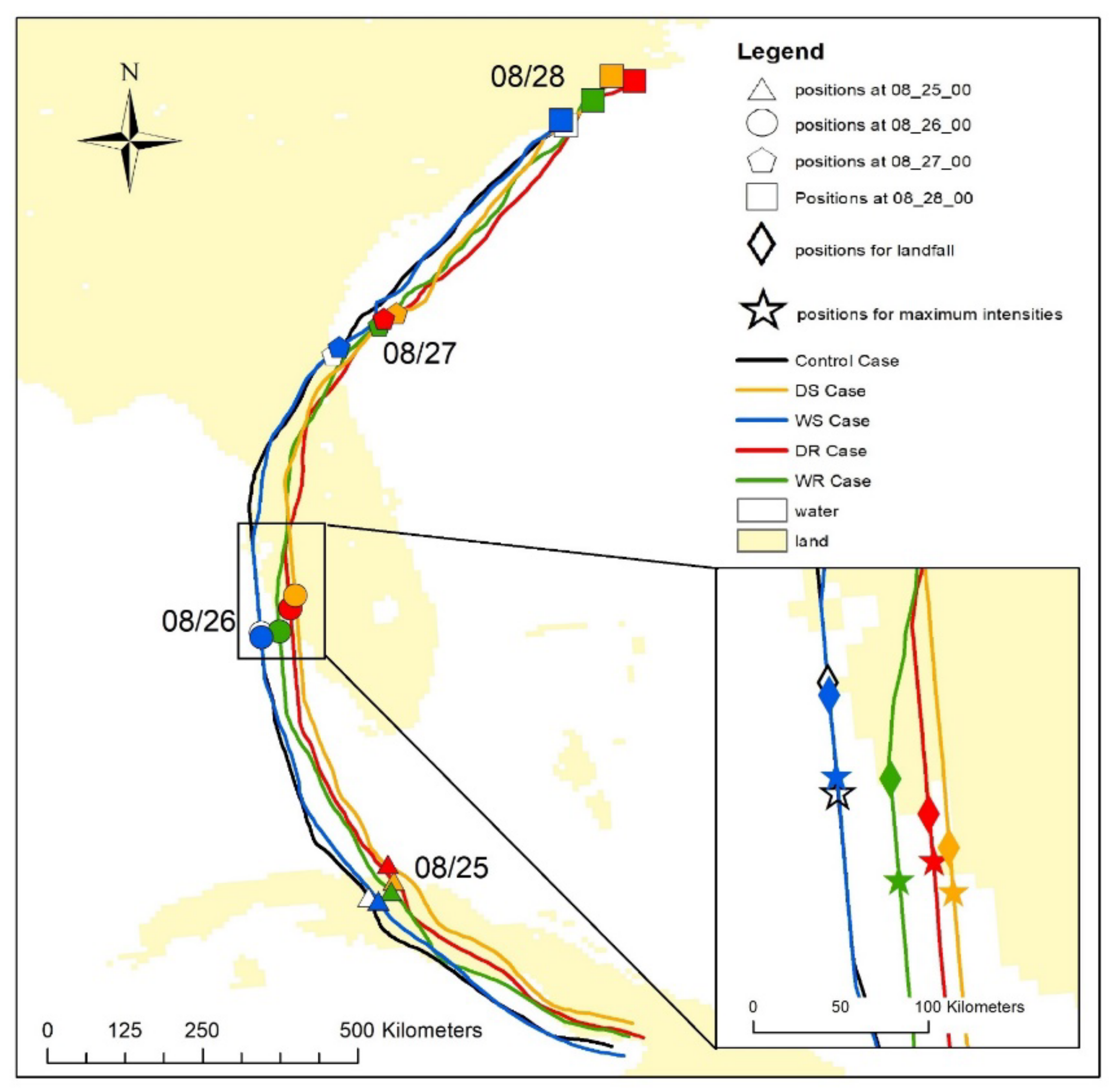

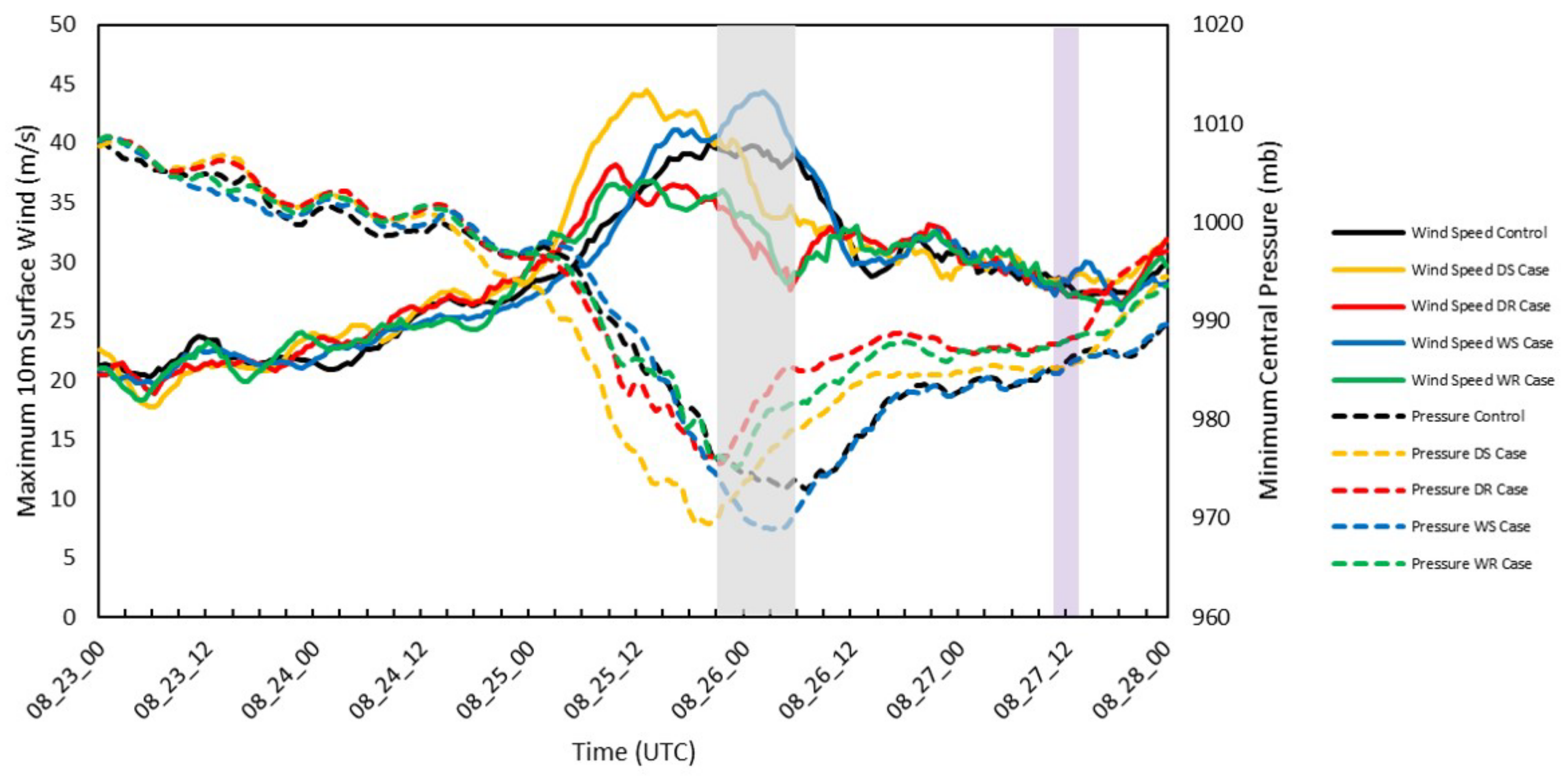
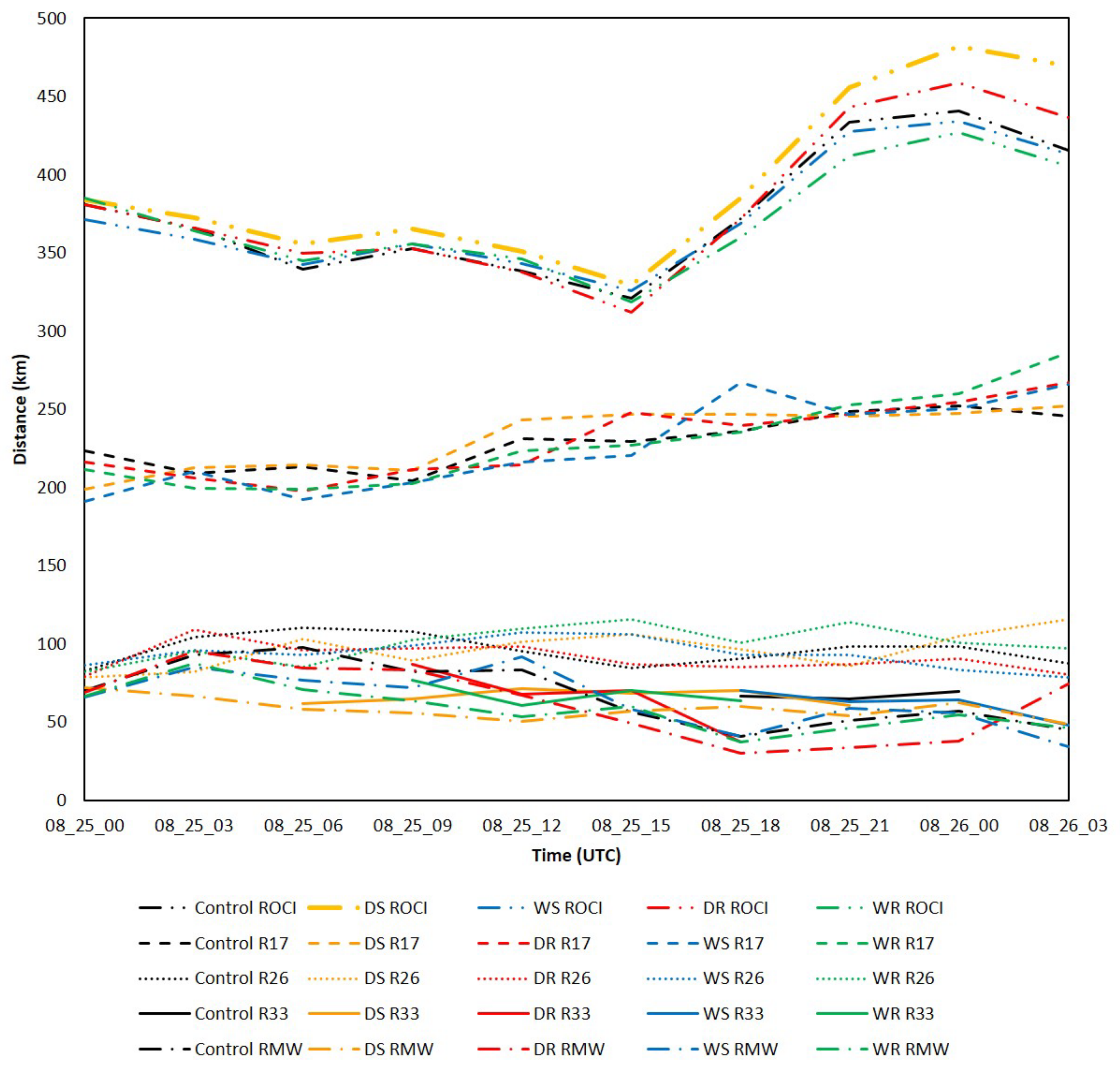
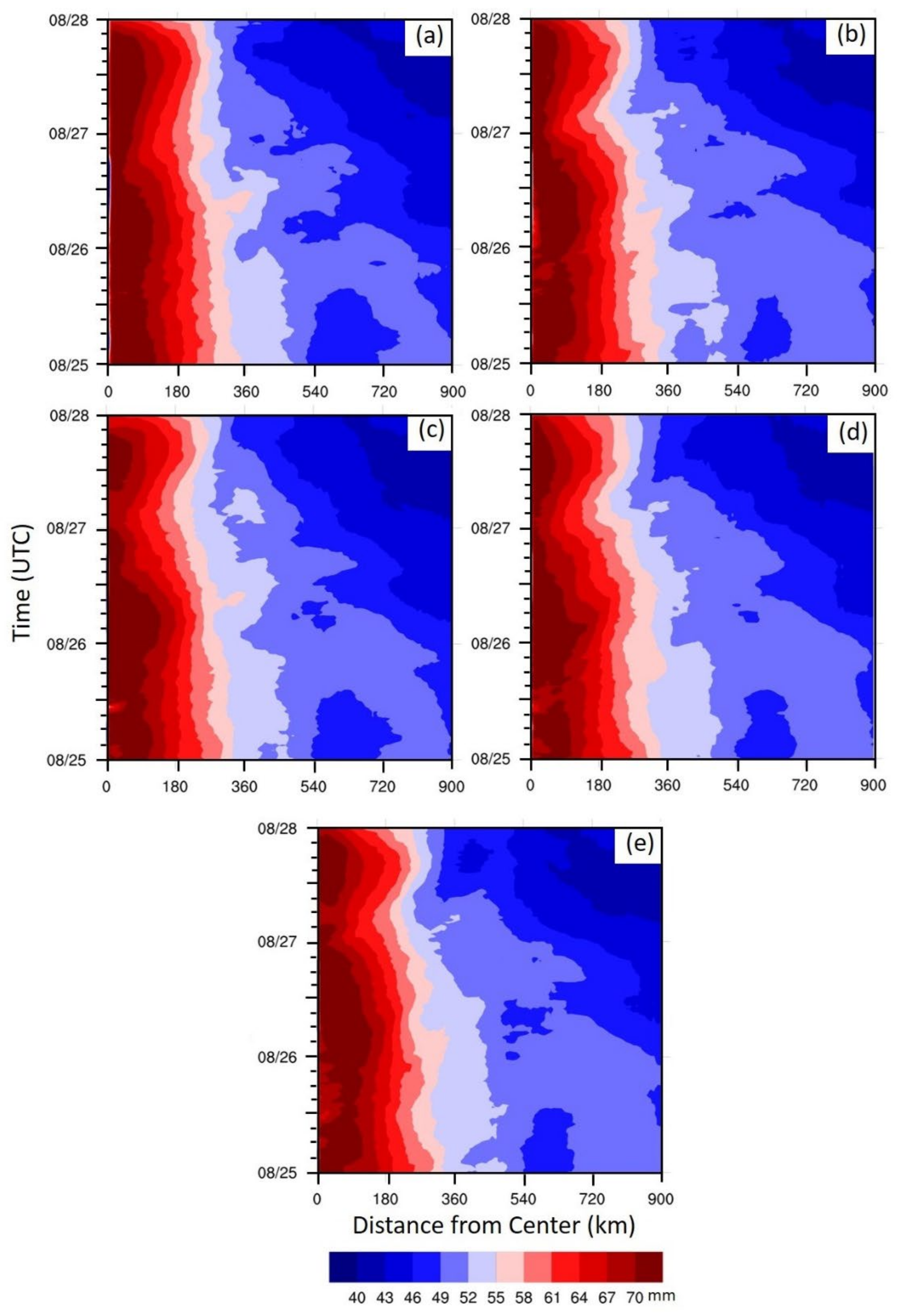



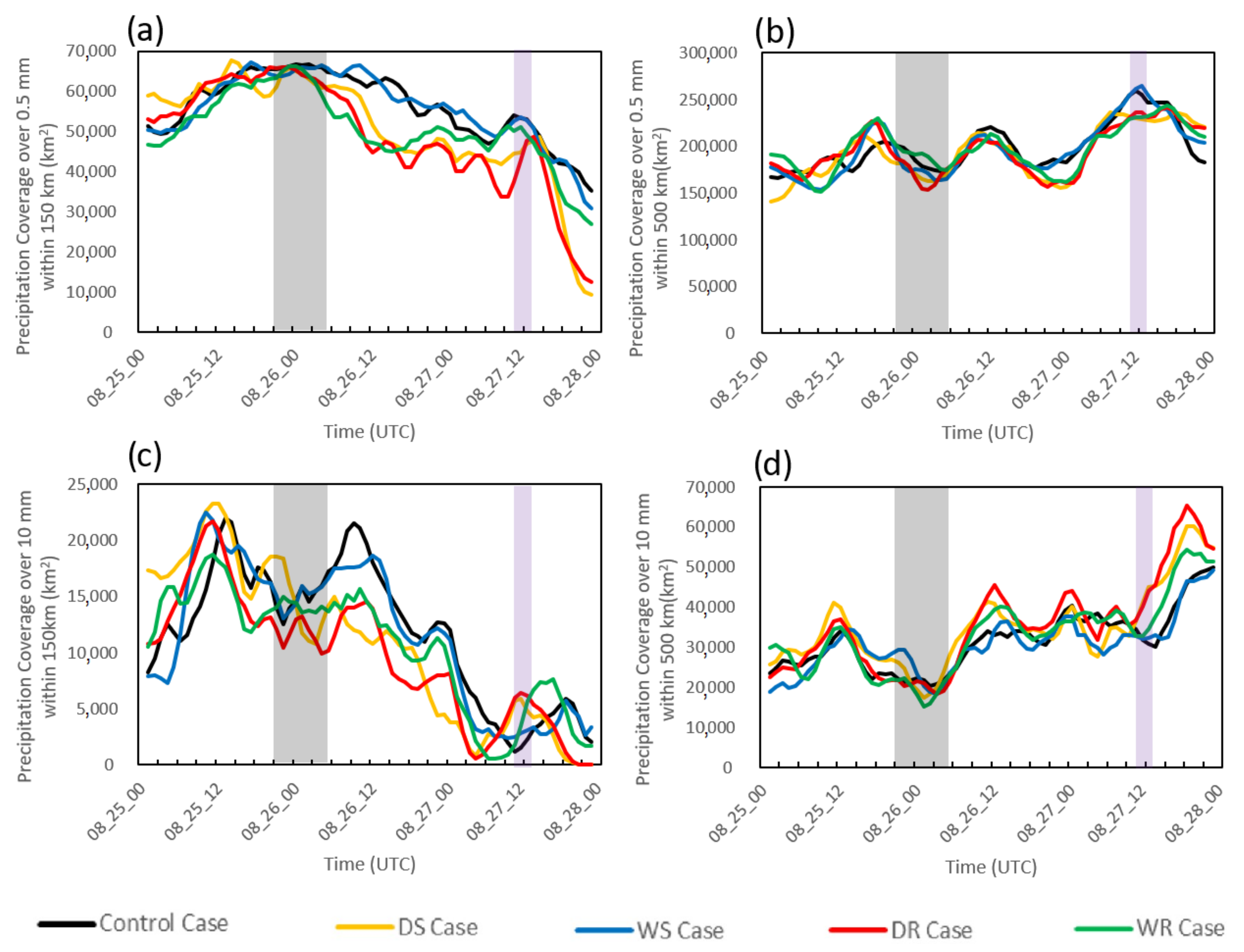
| Experiment Name | Vegetation/Land Use Type | Roughness Length (cm) | Soil Type | Moisture Availability |
|---|---|---|---|---|
| Dry Smooth (DS) | Wetland | 15 | Bedrock (dry) | 0% |
| Wet Smooth (WS) | Water (moist) | 100% | ||
| Dry Rough (DR) | Broadleaf Forest | 50 | Bedrock | 0% |
| Wet Rough (WR) | Water | 100% |
| (km) | R17 | R26 | R33 | RMW | ROCI |
|---|---|---|---|---|---|
| Moments | |||||
| Mean | 229 (222) | 95 (141) | 75 (92) | 63 (65) | 379 (352) |
| Std. dev | 23 (104) | 10 (68) | 10 (47) | 17 (36) | 43 (122) |
| No. of record | 50 (2708) | 50 (1737) | 21 (1071) | 50 (3161) | 50 (3389) |
| p-value | 0.63 | <0.01 | 0.10 | 0.70 | 0.12 |
| Period and Timing | LHF p-Value | SHF p-Value | FV p-Value |
|---|---|---|---|
| TBS All | 0.11 | 0.99 | 0.43 |
| TBS Day | <0.01 | <0.01 | 0.02 |
| TDS All | <0.01 | <0.01 | <0.01 |
| TDS Day | <0.01 | <0.01 | <0.01 |
| Case | LHF p-Value Higher Case | SHF p-Value Higher Case | FV p-Value Higher Case |
|---|---|---|---|
| Control vs. WS | 0.74 | 0.83 | 0.21 |
| Control vs. WR | 0.98 | 0.86 | 0.53 |
| Control vs. DS | <0.01 CNT | <0.01 DS | 0.22 |
| Control vs. DR | <0.01 CNT | <0.01 DR | 0.02 DR |
| WS vs. WR | 0.72 | 0.69 | <0.01 WR |
| WS vs. DS | <0.01 WS | <0.01 DS | 0.01 DS |
| WS vs. DR | <0.01 WS | <0.01 DR | <0.01 DR |
| WR vs. DS | <0.01 WR | <0.01 DS | 0.48 |
| WR vs. DR | <0.01 WR | <0.01 DR | 0.69 |
| DS vs. DR | 0.73 | 0.78 | 0.27 |
| Case | LHF p-Value Higher Case | SHF p-Value Higher Case | FV p-Value Higher Case |
|---|---|---|---|
| Control vs. WS | 0.46 | 0.09 | 0.34 |
| Control vs. WR | 0.90 | 0.13 | <0.01 WR |
| Control vs. DS | <0.01 CNT | <0.01 DS | <0.01 DS |
| Control vs. DR | <0.01 CNT | <0.01 DR | <0.01 DR |
| WS vs. WR | 0.53 | 0.88 | <0.01 WR |
| WS vs. DS | <0.01 WS | 0.03 DS | 0.02 DS |
| WS vs. DR | <0.01 WS | <0.01 DR | <0.01 DR |
| WR vs. DS | <0.01 WR | 0.02 DS | 0.02 WR |
| WR vs. DR | <0.01 WR | <0.01 DR | 0.10 |
| DS vs. DR | 0.48 | 0.13 | <0.01 DR |
| Distance from the Center | Accumulation Mean p-Value | Area > 0.5 mm h−1 p-Value | Area > 10 mm h−1 p-Value |
|---|---|---|---|
| 150 km | 0.02 | <0.01 | 0.04 |
| 500 km | 0.57 | 0.63 | 0.01 |
| Case | Accumulation Mean within 150 km Radius p-Value Higher Case | Area > 0.5 mmh−1within 150 km Radius p-Value Higher Case | Area > 10 mmh−1within 150 km Radius p-Value Higher Case | Area > 10 mmh−1within 500 km Radius p-Value Higher Case |
|---|---|---|---|---|
| Control vs. WS | 0.06 | 0.93 | 0.11 | 0.32 |
| Control vs. WR | 0.02 CNT | <0.01 CNT | 0.08 | 0.33 |
| Control vs. DS | 0.01 CNT | <0.01 CNT | 0.04 CNT | 0.03 DS |
| Control vs. DR | <0.01 CNT | <0.01 CNT | <0.01 CNT | 0.02 DR |
| WS vs. WR | 0.87 | <0.01 WS | 0.26 | 0.04 WR |
| WS vs. DS | 0.05 WS | 0.01 WS | 0.06 | <0.01 DS |
| WS vs. DR | <0.01 WS | <0.01 WS | <0.01 WS | <0.01 DR |
| WR vs. DS | 0.02 WR | 0.92 | 0.23 | 0.31 |
| WR vs. DR | <0.01 WR | 0.50 | <0.01 WR | 0.24 |
| DS vs. DR | 0.30 | 0.43 | 0.16 | 0.90 |
Publisher’s Note: MDPI stays neutral with regard to jurisdictional claims in published maps and institutional affiliations. |
© 2022 by the authors. Licensee MDPI, Basel, Switzerland. This article is an open access article distributed under the terms and conditions of the Creative Commons Attribution (CC BY) license (https://creativecommons.org/licenses/by/4.0/).
Share and Cite
Wang, Y.; Matyas, C.J. Simulating the Effects of Land Surface Characteristics on Planetary Boundary Layer Parameters for a Modeled Landfalling Tropical Cyclone. Atmosphere 2022, 13, 138. https://doi.org/10.3390/atmos13010138
Wang Y, Matyas CJ. Simulating the Effects of Land Surface Characteristics on Planetary Boundary Layer Parameters for a Modeled Landfalling Tropical Cyclone. Atmosphere. 2022; 13(1):138. https://doi.org/10.3390/atmos13010138
Chicago/Turabian StyleWang, Yu, and Corene J. Matyas. 2022. "Simulating the Effects of Land Surface Characteristics on Planetary Boundary Layer Parameters for a Modeled Landfalling Tropical Cyclone" Atmosphere 13, no. 1: 138. https://doi.org/10.3390/atmos13010138
APA StyleWang, Y., & Matyas, C. J. (2022). Simulating the Effects of Land Surface Characteristics on Planetary Boundary Layer Parameters for a Modeled Landfalling Tropical Cyclone. Atmosphere, 13(1), 138. https://doi.org/10.3390/atmos13010138







